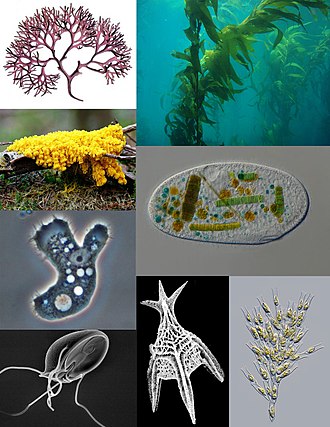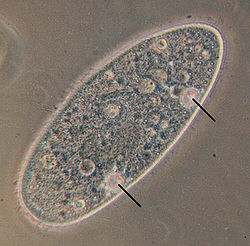Protist

Protists are single-celled eukaryotes (which are organisms with a nucleus). The term Protista was first used by Ernst Haeckel in 1866.[1] The protists are not a natural group, or clade, since they have no common origin. Like algae or invertebrates, they are often grouped together for convenience.
The term "protist" includes microorganisms from several distantly related phyla. Some are autotrophic (which means they make their own food by photosynthesis), and others are heterotrophic (which means they eat organic material).
Most protists are very small. They are made up of one or a few cells at most – they are microscopic and usually invisible to the naked eye. Some algae are protists, if they are single-celled. Many protists are part of the plankton and are very important for the ecosystem. The cells found in protists may be extremely complex, and are often little understood. It is now possible to do DNA sequencing, and a number of protists have been analysed. The results show that the Protista is not a monophyletic group. It is paraphyletic, and not a single clade. The taxonomy of the Protista is therefore rather confused.
Some protists cause diseases. Plasmodium falciparum causes malaria; sleeping sickness is also caused by a protist.
An example of a single celled organism in the protist kingdom is the Paramecium or "slipper animalcule." The Paramecium moves using its small, hair-like fibers called cilia, and eats using the cilia to sweep the food into its food vacuole. Other protists can be amoebas, which move by extending pseudopods and flowing into them, or flowing around food particles and engulfing them.
| Nutritional type | Source of energy | Source of carbon | Examples |
|---|---|---|---|
| Phototrophs | Sunlight | Organic compounds or carbon fixation | Algae, Dinoflagellates or Euglena |
| Organotrophs Heterotrophs | Organic compounds | Organic compounds | Apicomplexa, Trypanosomes or Amoebae |
Origin and taxonomy
Protists are not a monophyletic clade. The term is a convenient holdall for about 20 different kinds of single-celled eukaryotes.[2] They differ in their cell organelles, specialised units which carry out well-defined functions, like mitochondria and plastids. This proves they have made the transition from prokaryotes in different ways. It is fairly clear now that all or most of these organelles have their origin in once-independent prokaryotes (bacteria or archaea), and that the eukaryote cell is a 'community of micro-organisms' working together in 'a marriage of convenience'.[3][4][5][6] Admittedly, the Protista is a collection of disparate single-celled forms, but while a more sophisticated taxonomy is in flux (changing), Protista is still a useful term.
Protist Media
Difference between morphological (A) and genetic (B) view of total eukaryotic diversity. Protists dominate DNA barcoding analyses, but constitute a minority of catalogued species.
Structure of the cytostome-cytopharynx complex in Trypanosoma cruzi. The food travels the pre-oral ridge from the flagellar pocket until it reaches the cytostome and enters the cell through the cytopharynx, where nutrients are presumably transported by myosin proteins until they are enclosed in vesicles. The cytopharynx is supported by specific sets of microtubules.
The heliozoan Actinophrys sol phagocyting a Paramecium ciliate
Light micrograph of an ocelloid-containing dinoflagellate. n: nucleus, double arrowhead: ocelloid, scale bar: 10 μm.
Goldfuss' system of life, introducing the Protozoa within animals.
References
- ↑ Haeckel, E. Das Protistenreich. Leipzig, 1878. [1]
- ↑ Schaechter M. 2012. Eukaryotic microbes. Amsterdam, Academic Press.
- ↑ Margulis L. and McMenamin 1990. Marriage of convenience. The Sciences 30, 31-36.
- ↑ Margulis L & Dolan M.F. 2002. Early life: evolution on the Precambrian Earth. 2nd ed, Jones & Bartlett, Boston. p89
- ↑ Margulis L. Schwartz K.V. & Dolan M. 1999. Diversity of life: the illustrated guide to the five kingdoms. Jones & Bartlett, Boston, p94. In this work the authors propose 19 phyla for the Protista, and call this 'Kingdom' the 'Protoctista', a term which is unfortunately almost unpronounceable.
- ↑ Dyer B.D. and Obar R.A. 1994. Tracing the history of eukaryotic cells. Columbia N.Y.








